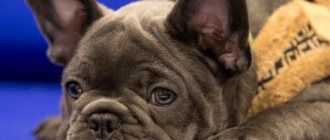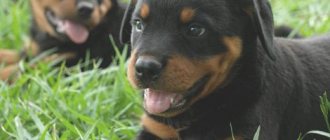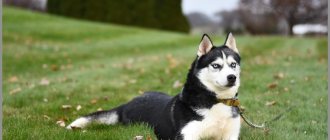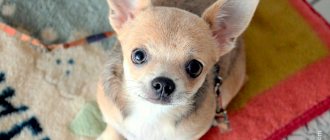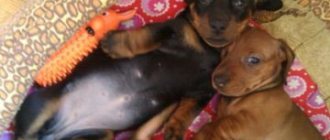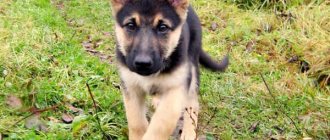Purchasing a puppy is an important event, second in importance only to the birth of a child, because a puppy is a new little member of the family. Dogs grow and mature quickly, so in the first days of living together with a puppy, you need to make a lot of effort so as not to harm his body and help him adapt to his new home.
Even before purchasing a puppy, you need to learn how to keep puppies, think about caring for a small pet, its diet and upbringing. Keeping puppies is difficult, but the efforts made will pay off: the family will have a cheerful and healthy dog that will give its owners many years of love and devotion.
Caring for puppies after birth or how to care for very small puppies?
First of all, you need to allocate a special place where the mother and her babies will be. You should equip it with everything necessary, make soft warm bedding, prepare an electric heating pad, it may be needed to warm the puppies, an electric scale for weighing the puppies, as well as a dog milk replacer in case the milk is not enough or the puppies are so weak that They will not be able to suckle milk on their own and will have to be given a milk replacer from a syringe.
Be prepared that in the first days of life of newborn puppies you will need to constantly be close to the dog and its puppies, this is especially true for a young dog that is bringing a litter for the first time. To do this, take a vacation and ask for help and share the schedule of care and control of the puppies and their mother with someone from the household.
If the dog is experienced, then caring for newborn puppies will not require much effort and attention from you. Dogs that are not mothers for the first time are distinguished by a very attentive and caring attitude towards puppies; they lick them especially carefully and regularly, which is very important for the life of newborn puppies. The fact is that licking stimulates blood circulation, digestion and bowel movements, as well as breathing of the newborn puppy. Newborn puppies cannot defecate on their own; it is the licking of the mother dog that stimulates this process. In the first days of the puppies' life, they lie clean and dry precisely thanks to such careful care on the part of their mother. If the dog is inexperienced or is in a weakened state after a cesarean section and cannot lick the puppies often, then you will have to periodically wipe the puppies’ bellies with a damp cloth and thus stimulate their vital processes.
From the first days of life, blind and deaf puppies are able to suck milk, making pushing movements with their front and rear paws; these actions create a massage of the nipples and stimulate milk production. It is very important that puppies first feed is colostrum. This is the first portion of milk that a dog produces during the first 3-5 days. The composition of colostrum has unique qualities; this milk contains nutrients and immunoglobulins that protect the weak organisms of puppies from various infections.
The sucking reflex is fixed from birth; puppies do not need to be taught this. However, there are situations when puppies are so weak that they cannot suck on their own or stay on the nipple. Then you need to help, hold the puppy, open his mouth and put the nipple in his mouth, first you need to massage the dog’s mammary glands so that colostrum is released from the nipple. The smell of colostrum will trigger the puppy's sucking reflex. If the puppies are very weak and are not able to suckle on their own, then they will have to be syringe-fed every 2 hours with a dog milk replacer. The first volumes of syringe feeding are 0.5-1 ml of milk; upon reaching a two-week period, the puppy can consume 5-10 ml of milk or milk replacer.
It is very important to monitor the weight of babies. Starting from the second day of life, puppies must be weighed daily and must gain weight daily. If this does not happen, it means the puppies are not getting enough nutrition, the mother does not have enough milk and you need to additionally feed them with milk or a milk substitute from a syringe.
Keep an eye on your dog's mammary glands; if there is an excess amount of milk, she may develop mastitis, which can be identified by swollen, hard and painful glands, they are hot and have a lumpy surface. At the first signs of mastitis, it is necessary to lubricate these glands affected by mastitis with camphor oil and perform a gentle massage to get rid of congestion in the mammary gland. If this doesn't help, be sure to contact your veterinarian!
Separate care should be taken to maintain warmth in the area where the puppies are located. Newborn puppies cannot control their body temperature and are susceptible to hypothermia. Puppies are warmed by their mother with her body, and puppies also warm each other by being in close contact. During the period when the mother is absent, she is on a walk or has gone to feed, the puppies need to be provided with additional heating, for this you need to use an electric heating pad.
Caring for newborn puppies requires constant monitoring. On days 7-10, you need to start trimming the puppies’ nails, just a little bit, just sharp hooks. Nails need to be trimmed once a week. This must be done so that the puppies do not injure the delicate skin of the mammary glands of the mother dog with their claws.
You also need to be especially careful to ensure that there is no inflammation of the navel stump in puppies. To do this, you need to lubricate your navel with brilliant green twice a day, morning and evening.
As puppies grow, they become more active; if at first they only sleep and eat, then from the third week of life, puppies begin to actively walk, defecate independently, play and fight with their brothers and sisters.
At the fourth week, the puppies have their first teeth, which means it’s time for complementary feeding. Gradually, the share of mother's milk in the puppies' diet will decrease; milk will be replaced by other foods.
The transition from milk to other products must be done gradually, and the condition of the puppies must be monitored. If the puppies are still weak, do not rush to switch them to another food. A gradual change in diet should take place in stages, first add one complementary food a day so that the puppy gets used to it, look at his reaction, then twice a day, then three, four, five, six until the mother’s milk is completely replaced.
What to feed the puppy?
Puppies are growing - this is a very important issue, there are two options here. Either you prepare food for your pets yourself, or you buy ready-made dry or wet food.
You cannot combine these types of feeds, as this will cause digestive upset. In addition, there is a possibility that feeding both prepared foods and additional food products will cause an excess of vitamins and minerals in the puppies’ diet, and this in turn will negatively affect the development of growing organisms.
The advantage of ready-made food is that it is developed by specialists taking into account all the puppy’s dietary needs. Ready-made food contains an optimal combination of proteins, fats, carbohydrates, vitamins and minerals, and also contains omega-3 fatty acids, which ensure normal development of vision and the nervous system.
But you need to choose food not of economy class, but of super premium class. Only super premium food contains natural products and is free of chemicals, dyes and GMOs. Moreover, in a wide range of foods you can find a variety of foods for dogs of different ages, the level of activity of the pet’s lifestyle, and they also take into account the dietary needs if the pet has certain diseases.
The German company Bosh produces super premium food for pets. Among the great variety of food there is food specially developed for small Bosh Puppy puppies. This food contains powdered milk to facilitate the start of complementary feeding and ensure the smoothest possible transition for the puppy to a new diet. This food is designed for puppies up to 3-4 months; other foods for young dogs no longer contain powdered milk, since over time, dogs’ ability to digest milk decreases. The package also indicates the diet and serving size for the puppy depending on its weight and age.
As a rule, small puppies up to a year are fed 4-6 times a day, then the number of feedings is reduced and by the age of one year it reaches 1-2 times a day.
In the “Food Selection” section, you can answer a few questions about your pet and get the best food option for your dog, which will fully take into account all the pet’s needs in the daily diet.
Health
When treating your pet, you need to completely trust the veterinarian, and not rely on your intuition. But every dog owner should have first aid skills.
A sick dog always tries to retire in a dark corner, does not respond to its name, suffers from lack of appetite and increased thirst. What does a shepherd puppy look like when unwell? His mucous membranes turn pale and yellow, the black color of his coat fades, and scratches are observed on his body. Body temperature is often elevated. If any of these signs are present, you should contact your veterinarian immediately.
The dog's health should be monitored by a veterinarian
To provide first aid, you must have a home first aid kit for your pet. Its composition:
- thermometer;
- pipette;
- syringes;
- syringes;
- rubber bands;
- scissors;
- tweezers;
- dressings (bandages, cotton wool, adhesive plaster);
- medications (iodine, hydrogen peroxide, brilliant green, potassium permanganate, boric acid, medical alcohol, painkillers and antipyretics);
- antiparasitic agents.
How to care for a 1 month old puppy?
Caring for a one-month-old puppy has its own characteristics. Since the puppy receives its first vaccination at 2 months, puppies must be wormed at the age of one and a half months. It is important to ensure that the puppy swallows and does not spit out the medicine. The dosage is very important, which is calculated based on the exact weight, size and age of the puppy. A weak dosage will not bring the desired effect, and an excessive dosage can cause poisoning or even death of the puppy. Therefore, read the instructions carefully, weigh the puppy, calculate the dosage and double-check the accuracy of your calculations.
Safe toys
Bored kids can literally destroy a house. Everything flies: furniture, wires, wallpaper, plaster... A small puppy who does not yet know how to direct his energy in the right direction should not be left alone. If you must do this, be sure to leave toys to keep the animal occupied.
- Rubber toys should be without a squeaker (a puppy can swallow it) and molded, non-hollow. The dog will chew the “pacifier” and try to eat it. It may even lead to surgery. Rubber rings and balls work great. In extreme cases, you can replace the toy with a hard treat that will take a long time to chew.
- You should not give your puppy ropes and threads, because he will certainly decide to eat them.
- The size of the toy should be such that it can be grabbed, but not swallowed.
- If your baby begins to lose interest, hide a few items for a week. When you give them again, the puppy will be happy.
Puppy toilet area
The puppy is 1 month old, care during this period also includes developing the skill of going to the toilet in a certain place. Puppies do not defecate in the same place they eat. Therefore, select a special place for the toilet away from food bowls, and lay a newspaper or diaper there. Having gone to the toilet in this place, the puppies will be guided by the smell and will get used to going to the toilet in a certain place.
From the age of 45 days, puppies need more attention from you. You need to play and communicate with them more. At this age, character begins to emerge, leaders, more active or calmer puppies are identified. This is a very important period; at this time, the puppy’s nervous system and psyche are formed, which depends not only on innate genes, but also on the animal’s experience of communicating with humans. Socialization of animals occurs.
Diseases and timely treatment
Due to the anatomical features of the Chihuahua, it is prone to a number of breed diseases:
- eye diseases;
- epilepsy;
- allergy;
- respiratory tract pathology;
- hydrocephalus;
- cryptorchidism;
- hypoglycemia;
- rheumatism.
When purchasing a puppy, you need to pay attention not only to its appearance, but also to the parents, get acquainted with the pedigree and ask the breeder about their health.
The pet should be periodically brought to the veterinarian for examination, and at the first suspicion of pathology, measures should be taken in accordance with his recommendations.
Moving a puppy
Caring for a puppy for 2 months. By 2 months, puppies are ready to go to a new home away from their mother and their siblings.
We talked about how to choose a place to purchase a puppy in the article “Buying a Puppy.”
The best place to buy is a professional club with a good reputation. The puppies in such clubs are purebred, have all the documents, are kept in excellent conditions, and are treated for parasites.
The care and maintenance of puppies largely determine the health of dogs in adulthood.
To care for your puppy in your home, you will need to organize a place for him to sleep and feed. Buy a carrier to transport your dog. Take it for growth, taking into account the future size of the maturing puppy. You will need to take your puppy to the veterinary hospital for vaccinations and routine examinations more than once.
Buy food and water bowls. Wash them thoroughly, change the water in the bowl, it must be fresh. Choose a cozy bed for sleeping. Ask the breeder to bring with you bedding with the scent of the puppy’s mother, this will make it easier for the puppy to adapt to the new place. Remember, the process of moving to a new place and separation from its mother is stressful for the animal; try to make the process of getting the puppy accustomed to your home as comfortable as possible.
Find out what kind of food your puppy was fed from the breeder, ask about the feeding regimen and serving size. Buy your puppy a variety of toys and balls, choose products made from safe materials, without small parts that the puppy can swallow.
Find out if the puppy is toilet trained. Remember that you can take your puppy out for a walk only after all vaccinations have been completed and quarantine has been completed.
Set up a special place in the apartment where the puppy can relieve himself, lay a diaper or newspaper there. You can purchase a special tray. Teach your puppy to wear a special diaper, wherever he is at that moment, spread the diapers in different places in the house. Then place the sheet on the tray. This will make it easier for him to understand what is required of him. Unfortunately, even if a puppy goes to the toilet in one specific place, this does not mean that he will not make a puddle in another place. Therefore, at this time it is better to remove the carpets in the apartment and cover the furniture with film.
Chihuahua in the house: where to start
Before picking up a puppy from the breeder, you should carefully prepare - carry out a general cleaning, remove small objects that he can reach, hide electrical wires, and close dangerous holes and cracks. A place for your pet will be organized in a cozy corner, where he can retire and relax on a soft mattress. The lounger should have removable covers to keep the bedding clean. For the Chihuahua, prepare dishes and a stand for it, a litter tray, toys, means and tools for maintaining hygiene, a carrier, a leash, a collar and overalls. There should be a first aid kit in the house.
The puppy is taken home in the morning so that before nightfall he has time to look around and get used to the new place a little. Immediately, the baby begins to be accustomed to a nickname and a toilet, based on how this happened with the breeder.
Veterinary examination of a puppy
But this is not the only thing puppies are accustomed to; care and vaccinations play a key role in maintaining the health of dogs. Therefore, dogs are taught to visit the veterinarian from a very early age. The first vaccinations should be given at the age of 2 months. Only healthy puppies are vaccinated; the puppy must be dewormed 15 days before vaccination; this is done before each vaccination.
There are two types of vaccinations - single vaccines (against one type of disease) and complex vaccines (against several diseases, for example, plague, rabies, hepatitis, enteritis, etc.). Complex vaccines are preferred.
After vaccination, a very important period of quarantine begins, which lasts about two weeks. During this period, the puppy’s body is weakened and susceptible to diseases, so it is necessary to protect the puppy from all potentially dangerous places of infection with any diseases. The puppy may have a fever, weakness, and diarrhea.
After 3 weeks, a secondary vaccination with the same vaccine takes place, this time the puppy survives it much easier. Again, you need to wait for a two-week quarantine and only then are you allowed to walk the puppy. The next vaccination period is 6 months, a rabies vaccination and a complex vaccine against several diseases are given. At this age, it is prohibited to vaccinate; if a dog’s teeth change, you need to wait until all the teeth have changed, only then vaccinate. The third vaccination is required at one year of age with a complex vaccine. And then vaccination is carried out on an annual basis with the same complex vaccine.
After the second vaccination and the quarantine period, you can start walking the puppy. At first, you need to walk the puppy often, 6-7 times, in the morning after sleep, before bed, after each meal. The puppy should get used to going to the toilet outside, so don’t expect piles and puddles to immediately disappear from your apartment. These little troubles can last until the dog is 6-7 months old. Over time, the number of walks can be reduced, the animal will get used to being patient.
Spaying and neutering a Chihuahua
If the owner of a Chihuahua does not intend to engage in breeding work, you should think about sterilization (castration) of the pet. The operation improves the animal’s quality of life and improves its health. As a result of sterilization, not only unplanned pregnancy is excluded, but also ovarian cancer, breast tumors, and estrus. The bitch's character is changing for the better. The operation is performed at the age of 6-7 months, before the onset of the first heat.
Males are castrated at 8-9 months. After surgery, they become less aggressive, more manageable, and the chance of developing a prostate infection decreases.
Puppy hygiene procedures
Caring for a puppy is also reflected in hygienic grooming procedures. It is necessary to bathe the puppy with special shampoos for puppies. They take into account that a puppy's coat is softer than an adult dog's. If you are bathing your puppy with shampoo for an adult dog, then the shampoo should be diluted with water. You need to bathe your puppy no more than once a month. Blow dry your puppy on low setting. Get your puppy used to brushing, especially if your breed has thick, fluffy fur. Some breeds require special haircuts and special coat care, so it is advisable to contact specialists, where your puppy will be provided with professional grooming services, given the correct haircut, and advice on how to care for your pet’s coat.
Features of keeping a Chihuahua
To ensure a comfortable stay for your Chihuahua, you should pay attention to some features of its maintenance:
- Chihuahuas' beds are located away from doors and radiators.
- Feeding utensils should be metal or ceramic.
- For the toilet, you can use both disposable and reusable diapers.
- Your pet should have a lot of toys.
- If there are other animals in the house, they are fed separately.
It is necessary to take care of the Chihuahua's fur - comb it, cut it and wash it on time. It is impossible to properly maintain without regular care of teeth, claws, ears and eyes. For the procedures, they purchase the necessary tools, shampoos, lotions and consumables.
You need to take special care of your female mini Chihuahua during heat. They use hygienic underpants, keep their genitals clean, don’t wear diapers when going for walks, and let the dog run around without them at home for at least a couple of hours.
In the house
In a private house, keeping and caring for a Chihuahua is much easier than in an apartment. Here the dog will find the most comfortable place to rest, perhaps even in several rooms. There is room for walking, so you can stay in the fresh air for a long time, which benefits both the owner and the pet. Training, training and teaching basic commands is convenient - the dog’s barking does not bother the neighbors. But there are also disadvantages. Due to the innate curiosity of a Chihuahua, the risk of getting into an unpleasant situation increases in the territory of a country house. Representatives of the breed love to dig the ground, stick their nose into all the cracks, and this threatens the mini-sized dog with danger.
In the apartment
It is easy to create conditions in an apartment in which the Chihuahua does not cause any particular inconvenience to the owners. She can be left alone for a long time, especially when there are toys. If something goes wrong, they install a small dog enclosure, which will protect the pet from danger, and the owners will not have to clean up the mess. For walking at home, a balcony or loggia is enough, but you need to think about safety in advance. It happens that Chihuahuas bark loudly and for a long time, causing inconvenience to neighbors. Early socialization, upbringing and training help to minimize such moments and teach them to behave correctly.
Active lifestyle of a puppy
are important . Caring for puppies is all about keeping them active.
dog's life. Without communication and active games with the owner, it is impossible for a puppy to develop harmoniously. Spend enough time to communicate with your new friend. The dog needs your communication with it. For a dog, the owner is his whole family. Games allow you to release energy, develop muscles, get your blood pumping, and keep your body healthy and strong. In the article “Raising a Puppy” you will learn more about how to organize your dog’s daily routine, how to teach it to certain actions, what to prohibit or allow your dog, and much more!
Love animals and take care of them!
Raising and teaching Chihuahua commands
Before purchasing a small dog, you should learn everything about the breed, its care, training and maintenance. Despite its small size, a Chihuahua can have a very unpredictable and stubborn character, so from the first days you need to not only take care of the baby, but also raise it.
The puppy is taught not to bark for no reason, not to beg, and to sleep in its place, and not in the owner’s bed. By one and a half months he should know his nickname, by three he should follow basic commands (“No”, “Sit”, “Fu”, “Near”). It is impossible to foresee all the nuances when raising a dog, but emerging problems with character and behavior can be solved with the help of adjustments.
